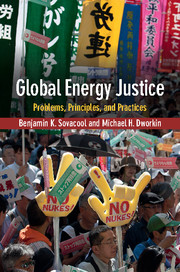Book contents
- Frontmatter
- Epigraph
- Dedication
- Contents
- Analytical table of contents
- List of figures
- List of tables
- Acknowledgements
- List of abbreviations
- 1 Introduction
- 2 The global energy system
- 3 Virtue and energy efficiency
- 4 Utility and energy externalities
- 5 Energy and human rights
- 6 Energy and due process
- 7 Energy poverty, access, and welfare
- 8 Energy subsidies and freedom
- 9 Energy resources and future generations
- 10 Fairness, responsibility, and climate change
- 11 The imperative of making just energy decisions
- Index
- References
10 - Fairness, responsibility, and climate change
Published online by Cambridge University Press: 05 October 2014
- Frontmatter
- Epigraph
- Dedication
- Contents
- Analytical table of contents
- List of figures
- List of tables
- Acknowledgements
- List of abbreviations
- 1 Introduction
- 2 The global energy system
- 3 Virtue and energy efficiency
- 4 Utility and energy externalities
- 5 Energy and human rights
- 6 Energy and due process
- 7 Energy poverty, access, and welfare
- 8 Energy subsidies and freedom
- 9 Energy resources and future generations
- 10 Fairness, responsibility, and climate change
- 11 The imperative of making just energy decisions
- Index
- References
Summary
Imagine for a moment that you are the governor of the state of Washington in the United States, and that you are entering the final year of your first term. You fully intend to run again. Before then, however, you need to decide your position in a fierce debate that has emerged over the 6,809 MW Grand Coulee Dam on the Columbia River, the largest hydroelectric power station in the country and a key source of energy for Washington State. On the one hand, the dam itself is old – built originally between 1933 and 1942 – and most of its thirty-three hydroelectric generators are in need of expensive refurbishing and upgrades. It lacks a fish ladder, meaning that the Department of the Interior informs you that it permanently blocks fish migration, removing more than 1,700 square kilometers of critical spawning habitat for salmon. Naturalists and recreationists have called the facility an “eyesore,” and your officers tell you that removing it would enable the Washington State Parks Foundation to convert Franklin Delano Roosevelt Lake and Banks Lake, currently reservoirs for the dam, into a kayaking tourist attraction. You have read studies that project that closing and removing the dam will cost $100 million, but that the state will receive $310 million per year from increased fisheries and tourism revenues – enough to pay for the construction of new power plants in other places, offset the cost of dam removal, and still produce extra revenue for the state.
On the other hand, closing down the dam means that you may have to approve three new coal-fired power plants to offset the reduction in electrical capacity, thus doubling the state’s GHG emissions. Farmers across the Columbia River Basin warn that without the irrigable water that the dam provides, they would need to switch to more pesticide- and fertilizer-intensive crops, contributing even more to future emissions. Your advisors tell you that the remodeled Roosevelt Lake could become such an attractive tourist option that you would need to build a new highway and hotels, which would both need more energy-intensive materials (while they are being built) and sources of energy (once they are operational), again contributing to climate change.
- Type
- Chapter
- Information
- Global Energy JusticeProblems, Principles, and Practices, pp. 319 - 352Publisher: Cambridge University PressPrint publication year: 2014



